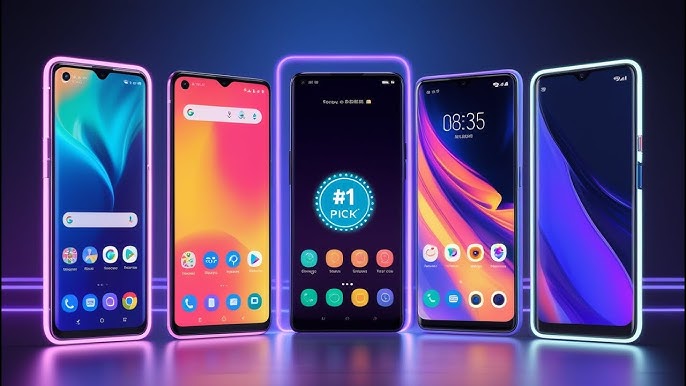
Flagship Android Phones 2024: A Reviewer’s Guide Beyond the Spec Sheet
The Annual Spectacle: Decoding the Modern Flagship Android Phone
Every year, the tech world braces for a tidal wave of new releases, each vying for the coveted title of the ultimate flagship. The cycle is predictable: dazzling launch events, embargoed reviews dropping in unison, and a deluge of spec sheets filled with ever-increasing numbers. More megapixels, faster gigahertz, brighter nits. For the average consumer, and even for seasoned enthusiasts, navigating this landscape can be overwhelming. The latest Android News often focuses on these headline-grabbing numbers, but the truth is, the story of a great flagship phone is written in the nuances, not just the numerals. A spec sheet can tell you what a phone has, but it can’t tell you how it feels.
This guide is designed to cut through that noise. We’re moving beyond a simple recitation of technical specifications to explore what truly defines a premium Android experience in 2024. We will delve into the critical pillars of performance, camera quality, and display technology, but more importantly, we’ll examine the intangible factors that create long-term value: software experience, ecosystem integration, and the practical application of artificial intelligence. From the versatile powerhouses of Samsung to the intelligent simplicity of Google’s Pixel line, this is your comprehensive look at the world of flagship Android Phones and the ecosystem of Android Gadgets they support.
Section 1: Beyond the Spec Sheet: The New Pillars of a Flagship Experience
For years, the flagship formula was simple: pack in the fastest processor, the highest resolution screen, and the most camera lenses. While these elements are still foundational, the market has matured. The law of diminishing returns has set in, and the real innovation now lies in refinement, intelligence, and longevity. What truly separates a good phone from a great one in 2024 are the pillars that support the raw hardware.
The Holy Trinity, Reimagined: Performance, Camera, and Display
The core components of a smartphone are still paramount, but the metrics for judging them have evolved significantly.
Performance: It’s no longer just about the chipset’s name (e.g., Snapdragon 8 Gen 3). The crucial factor is sustained performance. How does the phone manage heat during a 30-minute gaming session or when recording 4K video? A slim, fashion-forward phone might post great benchmark scores but will throttle its performance significantly under load to prevent overheating. In contrast, a gaming-focused device like an ASUS ROG Phone uses sophisticated cooling to maintain peak performance for longer. For most users, the real measure of performance is UI fluidity—how smoothly the phone scrolls, switches apps, and responds to touch. This is a delicate dance between powerful hardware and optimized software.
Camera: The megapixel war is effectively over. A 200MP sensor is meaningless if the software processing is poor. The new frontier is computational photography. Google’s Pixel line is a prime example, often using technically less advanced sensors but achieving stunning results through industry-leading AI and HDR processing. The real-world difference is in consistency. Can the phone reliably capture a great photo of a moving pet in tricky lighting? Does its portrait mode produce natural-looking background blur? Furthermore, hardware versatility remains a key differentiator. Samsung’s Galaxy S Ultra series, with its periscopic zoom lenses, offers a level of optical reach that software alone cannot replicate, making it a superior choice for concert-goers or wildlife photographers.
Display: A high refresh rate (120Hz or more) is now standard. The new benchmarks for a top-tier display are peak brightness and color accuracy. High peak brightness (often exceeding 2000 nits) is not a gimmick; it’s what makes a screen genuinely usable in direct sunlight. For content creators and photography enthusiasts, color accuracy and support for various HDR standards are critical for ensuring that what you see on your screen matches the final product. Finally, LTPO (low-temperature polycrystalline oxide) technology allows for an adaptive refresh rate that can drop as low as 1Hz, preserving battery life when viewing static content.
Section 2: The Great Divide: A Deep Dive into the Flagship Contenders
The Android ecosystem is defined by its diversity, and nowhere is this more apparent than in the flagship space. While many phones use similar core components, their philosophies and target audiences are vastly different. Understanding these differences is key to finding the right device for your needs.
Samsung’s Galaxy S Series: The ‘Everything Phone’

Samsung’s approach is one of maximalism. Their flagship, particularly the Ultra model, is engineered to be a Swiss Army knife of mobile technology. It aims to have the best of everything, all in one package.
Strengths: Samsung consistently delivers the best displays in the industry—bright, vibrant, and color-accurate. Their camera systems are the most versatile, offering a wide range of focal lengths from ultra-wide to extreme telephoto. The inclusion of the S Pen in the Ultra model is a unique productivity tool that no competitor can match. Software-wise, One UI is packed with features, from the DeX desktop mode to advanced customization options through Good Lock.
Real-World Scenario: A business professional who uses their phone for everything. They start their day by signing documents and taking notes with the S Pen in a meeting. During their lunch break, they edit high-resolution photos on the brilliant AMOLED screen. In the evening, they connect their phone to a hotel TV using DeX to finish a presentation, enjoying a full desktop experience powered by their phone.
Common Pitfall: For some users, the sheer number of features and settings in One UI can be overwhelming. The camera processing can also lean towards oversaturated, vibrant colors, which may not appeal to those who prefer a more natural look.
Google’s Pixel Series: The ‘Smart Phone’
Google’s philosophy is centered on software and artificial intelligence. The Pixel is not about having the most impressive hardware specs; it’s about creating the most intelligent and helpful user experience.
Strengths: The Pixel offers the cleanest, most intuitive version of Android. Its greatest strength is the camera’s software processing, which produces consistently excellent photos with minimal effort. Exclusive AI-powered features like Call Screen (which screens spam calls for you), Magic Eraser (which removes unwanted objects from photos), and Best Take (which combines faces from multiple shots to get one perfect group photo) solve real-world problems in ways other phones don’t.
Real-World Scenario: A busy parent who wants to capture precious family moments without fussing with camera settings. They rely on the Pixel’s point-and-shoot simplicity to get a great shot every time. They use the Magic Eraser to remove a distracting tourist from a vacation photo and depend on the Recorder app’s live transcription feature to take notes during a PTA meeting. The latest Android News about AI features often originates with a Pixel-first launch.
Common Pitfall: Historically, Pixel hardware has sometimes lagged behind the competition in areas like charging speed, cellular modem performance, and raw processing power. While the gap is closing, those who demand the absolute cutting edge of hardware might look elsewhere.
Section 3: The ‘X-Factor’: AI, Software, and the Long-Term Value Proposition
The most significant shift in the flagship landscape is the focus on factors beyond the physical hardware. The intelligence of the software and the manufacturer’s commitment to supporting the device are now arguably more important than the processor it contains.
The AI Revolution in Your Pocket
Artificial intelligence has moved from a marketing buzzword to a suite of genuinely useful tools that are deeply integrated into the flagship experience. This is a core part of what makes modern Android Phones so powerful.
Practical AI Applications: Instead of abstract concepts, we now have concrete features. Google’s Gemini and Samsung’s Galaxy AI are at the forefront. Features like “Circle to Search” allow you to instantly look up anything on your screen without switching apps—a genuinely seamless way to gain information. “Live Translate” can translate a phone conversation in real-time, breaking down language barriers. AI-powered photo editing tools like Google’s Magic Editor allow for complex edits, like moving a subject or changing the color of the sky, with just a few taps.

Best Practice: When evaluating AI features, ask yourself: “Does this solve a real problem for me, or is it a novelty?” The best AI integrations are those that fade into the background and make everyday tasks simpler and faster. Be wary of features that require multiple steps or produce inconsistent results, as these are often gimmicks that you’ll use once and forget.
The Seven-Year Itch: Why Software Updates Matter More Than Ever
Perhaps the single most important development in the Android world has been the commitment to long-term software support. For years, this was Android’s Achilles’ heel compared to Apple’s iPhone.
A New Standard: Google and Samsung have now set a new industry standard by promising seven years of both OS updates and security patches for their flagship devices. This is a game-changer for the consumer. It means a phone purchased today will still be receiving new features and be protected from security vulnerabilities in 2031. This dramatically increases the long-term value of the device.
Detailed Explanation: It’s crucial to understand the two types of updates. OS updates (e.g., moving from Android 14 to Android 15) deliver new features and interface changes. Security patches are smaller, more frequent updates that fix vulnerabilities. A long-term promise for both ensures your device remains modern and safe. When considering a flagship from other brands, their update policy should be a critical factor in your decision. A phone with only two or three years of promised updates will have a much shorter effective lifespan, making it a poorer long-term investment.
Section 4: Making the Right Choice: A Practical Guide for the Modern User
With a deeper understanding of what defines a modern flagship, you can make a more informed decision. The best phone isn’t universal; it’s the one that best aligns with your specific needs and priorities.
Identify Your User Profile
Before you even look at a phone, analyze how you use your current device. What are your most frequent tasks? What are your biggest frustrations? This will help you identify your profile.
- The Power User / Creator: You live on your phone. You need multitasking prowess, a versatile camera system for both photos and video, and productivity tools like a stylus. Your phone is your mobile office.
Recommendation: The Samsung Galaxy S Ultra series is tailor-made for this profile. - The Everyday Photographer / AI Enthusiast: You value simplicity and reliability above all. You want a camera that captures life’s moments perfectly without any fuss, and you’re excited by smart features that make your life easier.
Recommendation: The Google Pixel series is your ideal companion. - The Performance Junkie / Gamer: Your priorities are speed, responsiveness, and battery life. You want the smoothest possible experience, the fastest charging, and a clean interface that stays out of your way.
Recommendation: Look towards brands like OnePlus, which traditionally excel in these areas.
Final Tips and Considerations
1. Feel is Everything: Never buy a phone without holding it first. A device can look perfect in photos, but its weight, balance, and in-hand feel are deeply personal. Visit a store to see how it feels in your pocket and how easy it is to use one-handed.
2. The Ecosystem Lock-in: Consider the other Android Gadgets you own or plan to buy. If you have a Samsung Galaxy Watch and Galaxy Buds, you’ll get a more seamless, integrated experience with a Samsung phone. The same is true for the Pixel ecosystem of devices.
3. Wait for the Six-Month Review: Launch day reviews are great, but long-term reviews that surface after three to six months of real-world use often reveal more about battery degradation, software bugs, and durability.
Conclusion: The Era of the Intelligent Device
The narrative around flagship Android Phones has fundamentally shifted. While the horsepower under the hood remains impressive, the true differentiators are now intelligence, user experience, and long-term value. The battle is no longer just about having the best hardware but about providing the smartest software and the longest-lasting support. Your choice between the hardware-rich versatility of a Samsung Galaxy, the AI-powered simplicity of a Google Pixel, or the raw performance of a OnePlus depends entirely on what you value in a daily companion.
As you read the latest Android News and prepare to make your next big tech purchase, remember to look beyond the spec sheet. Focus on the real-world application of features, the manufacturer’s commitment to the future, and the ecosystem that surrounds the device. In doing so, you’ll find more than just a powerful piece of hardware; you’ll find a truly intelligent device that enriches and simplifies your life for years to come.



